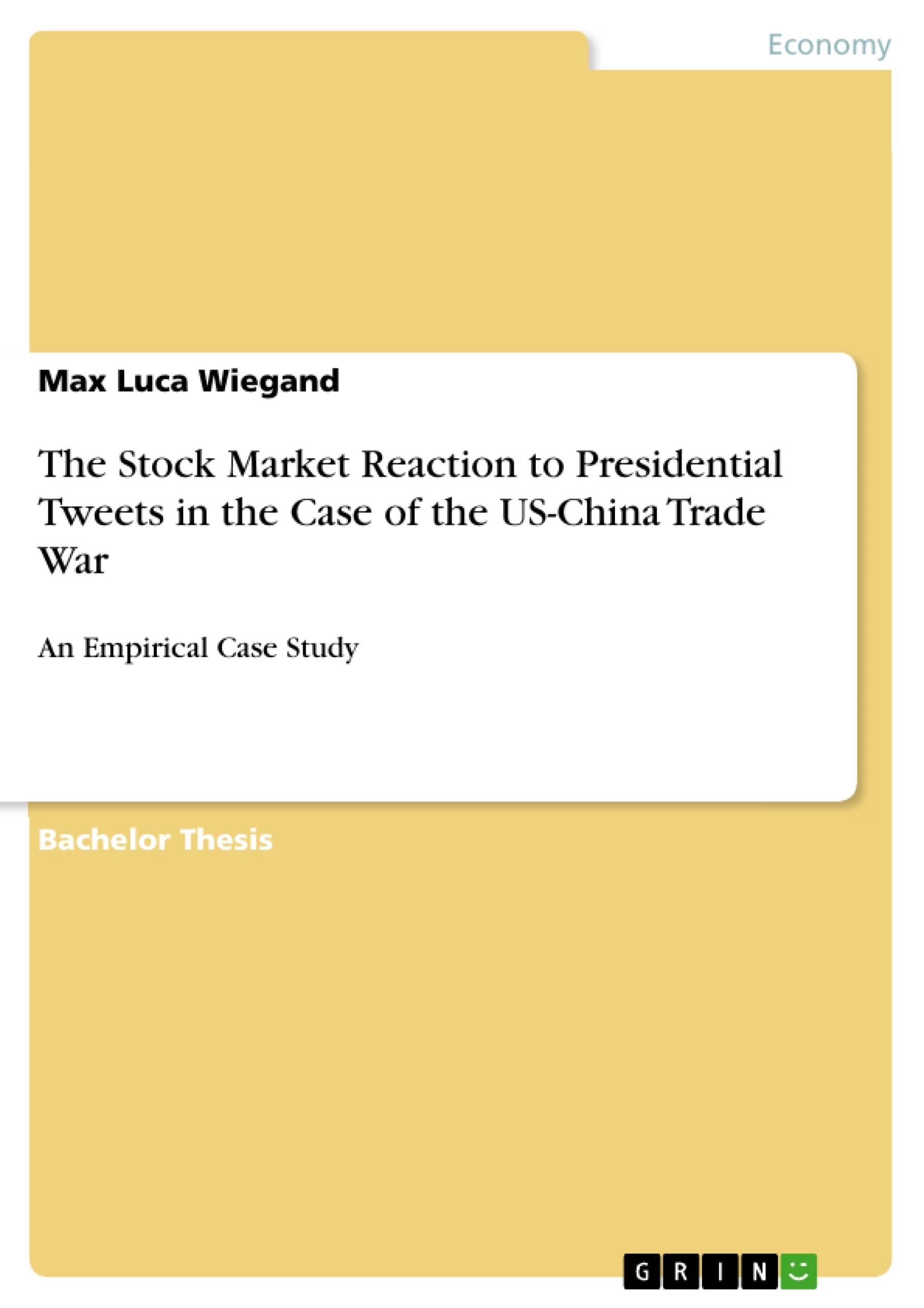In times of an increasingly digitalized world, behavioral changes in society do not spare high-ranking politicians and decision makers. In some cases, those changes in behavior can have unforeseen yet considerable consequences. By making use of the renowned event study methodology, this paper scrutinizes the impact of acting U.S. president Donald Trump’s Twitter activity on international stock markets. In particular, a select set of ten short messages posted in the context of the present US-China trade dispute is analyzed with regard to the U.S. American S&P 500, the Chinese Hang Seng Index (HSI) and the German DAX.
Highly significant market reactions, both positive and negative, are found for the HSI and the examined markets’ aggregate, while Trump’s native market showed the least responsiveness to his tweets. Apart from that, the obtained results suggest a fairly rapid processing of new information and thus adjustment of prices.
Ever since Donald Trump’s official inaugural address as the 45th president of the United States of America in January 2017, he has been cherishing a very polarizing and distinct way of leading the world’s largest economy compared to his more recent predecessors. That leadership style is not least characterized by his preferred yet – considering his position – rather uncommon way of communicating to the outside world, namely his extensive use of microblogging service Twitter for presidential announcements and commentaries of any nature. Amongst others, a particularly high activity can be observed
in conjunction with the rising political and economic tensions between the United States and China that have been intensifying over Trump’s course of presidency.
The dispute between the two economic superpowers – it comprises various topics such as the United States’ massive and long-standing trade deficit and alleged intellectual property theft – ultimately lead to the imposition of a series of mutual tariffs worth hundreds of billions of U.S. dollars. And while Trump regularly keeps his followers updated about his thoughts, claims and the statuses of trade negotiations, stock markets around the globe seem to react heavily to the developments of what is referred to as the US-China trade war. The question arises whether those unscheduled and seemingly impulsive short messages can be a causal explanation for recent stock market movements.
Inhaltsverzeichnis (Table of Contents)
- 1 Introduction
- 2 Literature review
- 2.1 Financial markets' reaction to new information
- 2.2 The impact of macroeconomic announcements on U.S. stock markets
- 3 Event Study
- 3.1 Event Review - the US-China trade war
- 3.1.1 Emergence and sources of conflict
- 3.1.2 Development and imposed tariffs
- 3.2 Methodology and theoretical framework
- 3.2.1 Assumptions
- 3.2.2 Event definition and selection criteria
- 3.2.3 Event window, post-event window and estimation window
- 3.2.4 Expected return models and (cumulative) abnormal returns
- 3.2.5 Null hypothesis and statistical validation
- 3.3 Data description
- 3.1 Event Review - the US-China trade war
- 4 Discussion of results
- 4.1 Events' impacts on aggregated stock market valuations
- 4.2 Events' impacts on stock markets on a country level
- 4.2.3 U.S. American stock market - S&P 500
- 4.2.4 Chinese stock market – Hang Seng Index
- 4.2.5 German stock market – DAX
- 4.3 Overview and conclusion
- 4.4 Quality of the study and limitations
Zielsetzung und Themenschwerpunkte (Objectives and Key Themes)
This paper analyzes the impact of U.S. President Donald Trump's Twitter activity on international stock markets, specifically during the US-China trade war. By employing the event study methodology, the paper aims to understand how these tweets affect the S&P 500, the Hang Seng Index, and the DAX.
- Impact of political communication on financial markets
- Event study methodology and its application to analyzing stock market reactions
- The role of Twitter in shaping market sentiment and influencing investment decisions
- Comparative analysis of market responses across different countries
- The dynamics of the US-China trade war and its implications for global markets
Zusammenfassung der Kapitel (Chapter Summaries)
The introduction provides an overview of the research question and its relevance in the context of a digitalized world, where the actions of high-ranking officials can have significant implications. Chapter 2 reviews existing literature on financial markets' reaction to new information and the impact of macroeconomic announcements on the U.S. stock market.
Chapter 3 delves into the event study methodology. It describes the context of the US-China trade war, outlining the conflict's origins and the development of imposed tariffs. The chapter then outlines the methodology's theoretical framework, including assumptions, event definition, selection criteria, event windows, and the calculation of abnormal returns. Finally, it presents the data description used in the analysis.
Chapter 4 discusses the findings of the study, analyzing the impact of Trump's tweets on stock market valuations both across markets and on a country level, examining the responses of the S&P 500, the Hang Seng Index, and the DAX.
Schlüsselwörter (Keywords)
This paper focuses on the impact of political communication, particularly through Twitter, on global stock markets, specifically examining the US-China trade war and its implications for the S&P 500, the Hang Seng Index, and the DAX. The research utilizes event study methodology, analyzing market reactions to new information and focusing on concepts like abnormal returns, market sentiment, and the role of social media in shaping investment decisions.
- Arbeit zitieren
- Max Luca Wiegand (Autor:in), 2019, The Stock Market Reaction to Presidential Tweets in the Case of the US-China Trade War, München, GRIN Verlag, https://www.grin.com/document/511509



